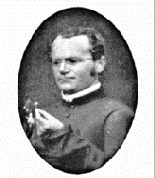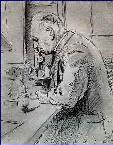
We've seen DNA itself, but what are genes?
Genes are not trousers! Genes are stretches of the DNA which code for one protein. We'll see exactly how a gene codes for a protein a little later, but let's concentrate on genes themselves for the moment.
Genes are 'units of inheritance'. What on earth does that mean??? It means that they are chunks of information that are passed from parents to children. Let's have a look at how that works.
The first important thing to remember is that we have two copies of each gene - one of those comes from our mum and one from our dad. It's just the same for other animals and for plants too!
| A man called Gregor Mendel (1822-1884) first worked this out towards the end of the 19th century. Mendel was an Augustinian monk who loved nature. He frequently walked around the gardens of the monastery looking at the plants and found an unusual variety of an ornamental plant. He planted it next to a typical variety and found that the offspring had characteristics of the parents. He realized that the characteristics were 'inherited' from the parents rather than being a result of where the plants were planted. He suggested that the characteristics of genes could be 'dominant' (the offspring would show these characteristics) or 'recessive' (these characteristics would be masked by the dominant version of the gene). You can read more about his theories here. |  |
 |
William Bateson (1861-1926) went on to do experiments on peas and chickens and defined the terms 'homozygous' (meaning a cell has two identical copies of a gene), 'heterozygous' (meaning a cell as two different versions of a gene) and referred to the different versions as 'alleles'. This was the birth of modern genetics! You can read more about Bateson here. |
Continue to the Next Page to see what all this means!